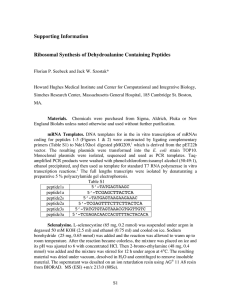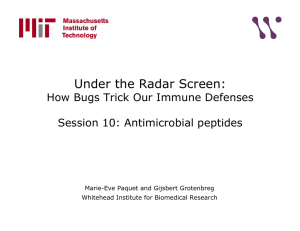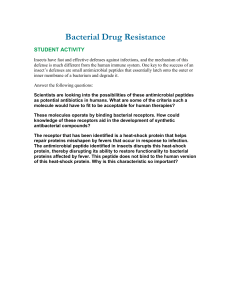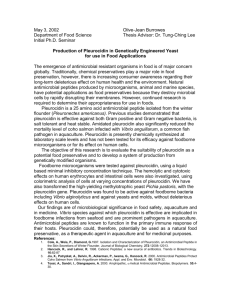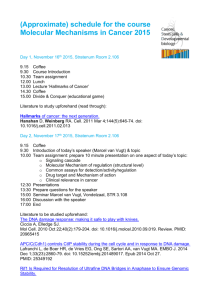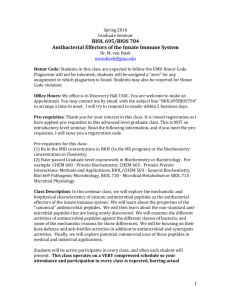Generation and characterization of the antibacterial activity of a novel hybrid
advertisement
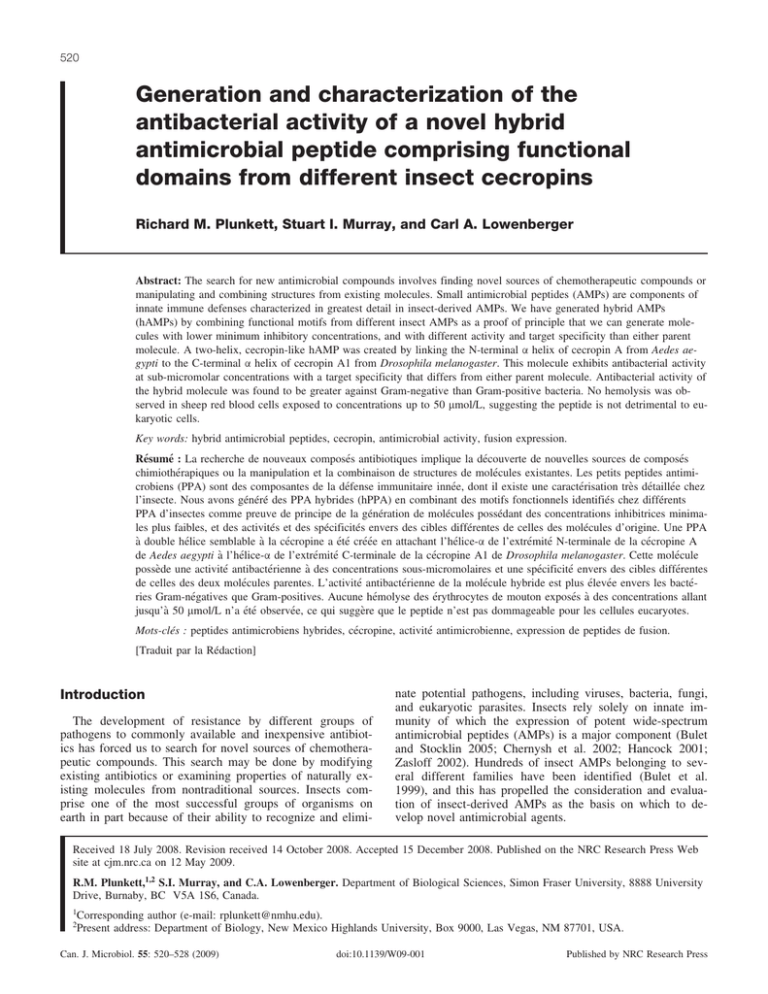
520 Generation and characterization of the antibacterial activity of a novel hybrid antimicrobial peptide comprising functional domains from different insect cecropins Richard M. Plunkett, Stuart I. Murray, and Carl A. Lowenberger Abstract: The search for new antimicrobial compounds involves finding novel sources of chemotherapeutic compounds or manipulating and combining structures from existing molecules. Small antimicrobial peptides (AMPs) are components of innate immune defenses characterized in greatest detail in insect-derived AMPs. We have generated hybrid AMPs (hAMPs) by combining functional motifs from different insect AMPs as a proof of principle that we can generate molecules with lower minimum inhibitory concentrations, and with different activity and target specificity than either parent molecule. A two-helix, cecropin-like hAMP was created by linking the N-terminal a helix of cecropin A from Aedes aegypti to the C-terminal a helix of cecropin A1 from Drosophila melanogaster. This molecule exhibits antibacterial activity at sub-micromolar concentrations with a target specificity that differs from either parent molecule. Antibacterial activity of the hybrid molecule was found to be greater against Gram-negative than Gram-positive bacteria. No hemolysis was observed in sheep red blood cells exposed to concentrations up to 50 mmol/L, suggesting the peptide is not detrimental to eukaryotic cells. Key words: hybrid antimicrobial peptides, cecropin, antimicrobial activity, fusion expression. Résumé : La recherche de nouveaux composés antibiotiques implique la découverte de nouvelles sources de composés chimiothérapiques ou la manipulation et la combinaison de structures de molécules existantes. Les petits peptides antimicrobiens (PPA) sont des composantes de la défense immunitaire innée, dont il existe une caractérisation très détaillée chez l’insecte. Nous avons généré des PPA hybrides (hPPA) en combinant des motifs fonctionnels identifiés chez différents PPA d’insectes comme preuve de principe de la génération de molécules possédant des concentrations inhibitrices minimales plus faibles, et des activités et des spécificités envers des cibles différentes de celles des molécules d’origine. Une PPA à double hélice semblable à la cécropine a été créée en attachant l’hélice-a de l’extrémité N-terminale de la cécropine A de Aedes aegypti à l’hélice-a de l’extrémité C-terminale de la cécropine A1 de Drosophila melanogaster. Cette molécule possède une activité antibactérienne à des concentrations sous-micromolaires et une spécificité envers des cibles différentes de celles des deux molécules parentes. L’activité antibactérienne de la molécule hybride est plus élevée envers les bactéries Gram-négatives que Gram-positives. Aucune hémolyse des érythrocytes de mouton exposés à des concentrations allant jusqu’à 50 mmol/L n’a été observée, ce qui suggère que le peptide n’est pas dommageable pour les cellules eucaryotes. Mots-clés : peptides antimicrobiens hybrides, cécropine, activité antimicrobienne, expression de peptides de fusion. [Traduit par la Rédaction] Introduction The development of resistance by different groups of pathogens to commonly available and inexpensive antibiotics has forced us to search for novel sources of chemotherapeutic compounds. This search may be done by modifying existing antibiotics or examining properties of naturally existing molecules from nontraditional sources. Insects comprise one of the most successful groups of organisms on earth in part because of their ability to recognize and elimi- nate potential pathogens, including viruses, bacteria, fungi, and eukaryotic parasites. Insects rely solely on innate immunity of which the expression of potent wide-spectrum antimicrobial peptides (AMPs) is a major component (Bulet and Stocklin 2005; Chernysh et al. 2002; Hancock 2001; Zasloff 2002). Hundreds of insect AMPs belonging to several different families have been identified (Bulet et al. 1999), and this has propelled the consideration and evaluation of insect-derived AMPs as the basis on which to develop novel antimicrobial agents. Received 18 July 2008. Revision received 14 October 2008. Accepted 15 December 2008. Published on the NRC Research Press Web site at cjm.nrc.ca on 12 May 2009. R.M. Plunkett,1,2 S.I. Murray, and C.A. Lowenberger. Department of Biological Sciences, Simon Fraser University, 8888 University Drive, Burnaby, BC V5A 1S6, Canada. 1Corresponding 2Present author (e-mail: rplunkett@nmhu.edu). address: Department of Biology, New Mexico Highlands University, Box 9000, Las Vegas, NM 87701, USA. Can. J. Microbiol. 55: 520–528 (2009) doi:10.1139/W09-001 Published by NRC Research Press Plunkett et al. Most insect AMPs are small (20–100 amino acids) cationic peptides that contain at least one region that forms an a-helical structure that binds to hydrophobic surfaces, such as microbial membranes. While the specific modes of action are not completely understood, it is generally accepted that they first bind to the bacterial cell surface and then either disrupt or penetrate the membrane. Toxicity may result from damage to external membranes or by action against intracellular structures or processes (Brogden 2005; Tossi et al. 2000). For example, cecropins attack membranes, but also have been shown to affect cellular processes in Escherichia coli by altering gene transcription (Hong et al. 2003). Cecropins have one of the simplest AMP structures, which comprises 2 short a helices joined by a non-helical hinge. Cecropins were isolated first from the moth Hyalophora cecropia (Boman and Steiner 1981; Steiner et al. 1981), and later described in other lepidopterans (Dickinson et al. 1988; Sumida et al. 1992) and dipterans (Liang et al. 2006; Lowenberger et al. 1999; Vizioli et al. 2000; Zhou et al. 1997). While the general two-helix structure is conserved in all cecropins, the primary sequence of amino acids can differ significantly among cecropins from different insect orders (Bulet and Stocklin 2005). These modifications may contribute to the different spectrum of activity of each of these molecules. In addition to sequence variability, certain structural modifications of cecropins may contribute to determining the target specificity and structural stability (Bulet and Stocklin 2005; Imler and Bulet 2005). Many cecropins from dipterans and lepidopterans are post-translationally amidated at the C terminus, which may help maintain the stability and cationic nature of the molecule. An N-terminal tryptophan residue is present in the first or second position of most lepidopteran and dipteran cecropins but is absent in cecropin D from the silkworm Bombyx mori and in mosquito cecropins. Whereas other studies have combined structures from diverse AMPs in non-natural configurations (Boman et al. 1989; Hongbiao et al. 2005; Otvos et al. 2005; Shin et al. 1999), we designed hybrid AMPs (hAMPs) by combining components of homologous peptides from different insects. This approach allows us to select structures and tailor the design of hAMPs to target specific groups of microbes (e.g., methicillin-resistant Staphylococcus aureus). Insect AMPs have been selected throughout evolution for low toxicity to eukaryotic cells and low target resistance by bacteria. As the numbers of antibiotic-resistant pathogens increase, insect AMPs, with an enormous potential of combinations and permutations of structures that can be employed, may provide us with the basis of future antibiotics. A consideration when developing hybrid AMPs for evaluation is their production in large quantities. Synthetic peptides are useful because they can be obtained in high purity, but at a high cost. Bacterial expression systems are commonly used for producing large amounts of recombinant protein, also with high purity and at a lower cost. When the recombinant peptide is intended to have antimicrobial properties, it is important to protect the expression host from the toxic effects of product. We have used a bacterial system to express an antimicrobial peptide in E. coli as a fusion protein with a large nontoxic fusion partner bound to the hAMP, which effectively reduces its antibacterial activity against the expression host. 521 Here, we report the generation of a chimeric cecropin-like hAMP that was created by linking the N-terminal a-helical domain (residues 1–26 of the active peptide) of cecropin A from Aedes aegypti (Liverpool strain) (Lowenberger et al. 1999) by a proline hinge to the C-terminal a-helical domain (residues 27–40 of the active peptide) of cecropin A1 from Drosophila melanogaster (Canton-S) (Kylsten et al. 1990). This molecule exhibits antibacterial activity at sub-micromolar concentrations different to the activity of either parent molecule. We present the design, expression, and characterization of this hAMP in terms of its specific antibacterial activity against selected Gram-negative and Gram-positive bacteria. We also provide the results of tests evaluating its activity against eukaryotic cells using hemolytic activity assays. Materials and methods Synthetic peptides For initial studies of antibacterial activity, peptides corresponding to individual N- and C-terminal a-helical domains of cecropins from lepidopteran (Hyalophora cecropia cecropin, UniprotKB/Swiss-Prot acc. No. P01507) and dipteran insects (Ae. aegypti cecropin A, UniprotKB/Swiss-Prot acc. No. P82592; D. melanogaster cecropin A1, UniprotKB/ Swiss-Prot acc. No. P14954). Synthetic peptides were obtained from the Peptide Array/Peptide Synthesis Facility at the Brain Research Centre, University of British Columbia. Synthetic full-length AC(1–26)-DC(27–40) was purchased from GenScript Corp. (Piscataway, New Jersey) and used in antibacterial and hemolysis assays. Generation of the chimeric gene We created an artificial chimeric gene (Fig. 1) using a combination of overlap and recursive PCR methods (Prodromou and Pearl 1992; Warrens et al. 1997). Figure 2 is a schematic representation of the PCR process used in this study, and Table 1 describes the oligonucleotide primers used. We extracted RNA from the fat body of immune-activated Ae. aegypti, and generated cDNA as described previously (Cooper et al. 2007; Lowenberger et al. 1999). In the initial PCR reaction, we designed primers RP008F and RP002R to amplify the N-terminal a helix of Ae. aegypti cecropin A (GenBank acc. No. AF117886). The expression vector we used in this study (pET-32 Ek/LIC; Novagen, San Diego, California) utilizes a ligation-independent cloning (LIC) mechanism, which allows cloning without the need for restriction enzyme digestion. It was therefore necessary to generate PCR products with appropriate nucleotide sequences at each end, as described in the manufacturer’s directions. The forward primer RP008F included a sequence corresponding to a 3’ linker sequence to facilitate insertion into the cloning site of the pET-32 expression vector for subsequent expression studies. The PCR conditions were 95 8C (2 min) followed by 30 cycles of 95 8C (10 s), 55 8C (10 s), and 72 8C (30 s) and a final extension step of 72 8C (2 min). This PCR product was size-fractionated on 1.2% agarose, stained with ethidium bromide. A band of the expected size (106 bp) was excised from the gel and the DNA purified (QiaQuick Gel Extraction Kit; QIAGEN, Mississauga, Ontario). This DNA was used in a subsequent overPublished by NRC Research Press 522 Can. J. Microbiol. Vol. 55, 2009 Fig. 1. AC(1–26)-DC(27–40) artificial hybrid gene. (A) Alignment of AC(1–26)-DC(27–40) gene with Aedes aegypti (Ae. aeg. CecA1) and Drosophila melanogaster (D. mel. CecA1) cecropin genes. Portions used in hybrid gene are indicated with boxes; also indicated (labeled arrows) are the positions of primers used to generate AC(1–26)-DC(27–40); the proline hinge linking Ae. aegypti and D. melanogaster sections is indicated by a shaded box. (B) Nucleotide and translated amino acid sequences of AC(1–26)-DC(27–40). Linker sequences for pET32 eK/LIC vector are shown in underlined lower case; the proline hinge is indicated by a shaded box. lap PCR reaction using the initial RP008F primer and a 67 bp reverse primer (RP007R) that overlapped the template DNA by 22 bp, incorporated a proline hinge, continued with the C-terminal a helix of D. melanogaster cecropin CecA1 (GenBank acc. No. NM 079849), and incorporated a 5’ linker sequence subsequent expression studies. The PCR conditions were identical to those described above for the initial PCR reaction. The 152-bp product of the overlap PCR, our synthetic gene designated AC(1–26)-DC(27–40), was extracted from the gel and purified as described above, ligated into pGEMT Easy (Promega, Madison, Wisconsin), transformed into JM109 competent cells (Promega), and grown overnight as described (Lowenberger et al. 1999). Colonies were screened for inserts, and positive transformants were grown overnight in Luria–Bertani broth containing 50 mg/mL ampicillin (LB–AMP). Subsequent purified plasmid (SV Minipreps; Promega) was sequenced using Big Dye version 3.1 chemistry (ABI, Foster City, California). We used the plasmid as template for a PCR reaction using the insert-specific primers RP008F and RP009R that amplified the entire synthetic gene that was cloned into the protein expression vector pET-32 Ek/LIC according to the manufacturer’s instructions. The plasmid designated pET-32 AC-DC encodes our hAMP with an N-terminal thioredoxin (Trx) fusion partner, a 6His tag, and an enterokinase cleavage site. Purified pET-32 AC-DC plasmids were subsequently used to transform BL21(DE3) cells (Novagen, San Diego, California) for the expression of the recombinant fusion proteins. Expression and purification of recombinant fusion proteins Starter cultures for recombinant protein expression were made by inoculating LB–AMP with a single colony from an overnight plate of transformed BL21(DE3) cells (Novagen). Cells were incubated at 37 8C with shaking at 250 rev/min until they reached an optical density at 600 nm (OD600) of 0.6. Cells from 3.0 mL of the starter cultures were collected by centrifugation (5000g for 5 min at 4 8C), washed with 3.0 mL phosphate-buffered saline pH 7.4 (PBS), and resuspended in 3.0 mL LB–AMP. These were used to inoculate 500 mL LB–AMP, which was incubated with shaking at 37 8C and allowed to grow to an OD600 of 0.6, whereupon expression was induced by adding IPTG to a final concentration of 0.4 mmol/L, and cultures were incubated at 21 8C for 16 h after induction. Cells were harvested by centrifugation at 5000g for 20 min at 4 8C, and the supernatant was retained. The pellet was washed with 1 culture volume of PBS and stored at –80 8C. Harvested cells were resuspended in 10 mL PBS and mechanically disrupted by sonication in the form of 30 s bursts followed by 30 s rest (for a total of 12 min of sonication) while the sample was kept on ice. The soluble fraction was separated from cell debris by centrifugation at 7500g for 40 min at 4 8C. After centrifugation, the soluble fraction was either immediately subjected to nickelaffinity column purification or stored at –20 8C (with no apparent loss of protein recovery up to 2 months). The recombinant fusion protein contains a polyhistidine tag that binds to nickel ions, allowing purification of the Published by NRC Research Press Plunkett et al. Fig. 2. Overlap PCR method used to generate pET-32 Trx-AC(1– 26)-DC(27–40) construct. (A) First round of PCR used Aedes aegypti cDNA as the template to produce a fragment containing a partial Ae. aegypti cecropin gene (white) with a 3’ overlap for the Drosophila melanogaster cecropin gene (grey) and a 5’ linker sequence for the pET-32 Ek/LIC vector (black). (B) The product from (A) was the target for an overlapping PCR to produce the fulllength AC(1–26)-DC(27–40) with both Ae. aegypti and D. melanogaster segments and 5’ and 3’ pET-32 linkers. (C) The product of (B) was used to generate the pET-32 Trx-AC(1–26)-DC(27–40) construct, featuring a thioredoxin fusion partner (Trx), a polyhistidine tag (6His) for purification, and an enterokinase cleavage site (Ek) to release the recombinant AC(1–26)-DC(27–40) peptide. proteins from cell debris with a nickel affinity column. A volume of 2.5 mL of cleared cell lysates was bound to a bed volume of 500 mL of nickel–nitrilotriacetic (Ni–NTA) agarose (QIAGEN) that had been equilibrated by washing twice with water and once with binding buffer (20 mmol/L Tris pH 7.9, 0.5 mol/L NaCl, and 5 mmol/L imidazole). The mixture then was added to cleared lysate containing 10 mmol/L imidazole. The combined Ni–NTA agarose and sample lysate were mixed on a rotator for 1 h at 4 8C then applied to a 10 mL gravity flow column, which had been washed with water and pre-equilibrated with binding buffer. The column was washed twice with 20 mmol/L Tris pH 7.9, 523 0.5 mmol/L NaCl, and 30 mmol/L imidazole. Bound protein was eluted from the column with 20 mmol/L Tris pH 7.9, 0.5 mol/L NaCl, and 100 mmol/L imidazole. Column flowthrough, washes, and eluted fractions were collected for analysis by SDS–PAGE. After affinity column purification, the eluted fusion protein was concentrated by centrifugation in an Amicon Ultra filter device (Millipore Corp., Billerica, Massachusetts) with a molecular mass cutoff of 10 kDa. Samples were centrifuged at 7500g at 4 8C to approximately one-tenth volume then washed in the filter device 3 times with 2.5 mL PBS by centrifugation, then resuspended in 250 mL PBS. The hAMP region of the fusion protein was separated from the Trx-6His fusion partner by cleavage with recombinant enterokinase (rEK) (Novagen). Cleavage reactions took place in 1 rEK Cleavage/Capture buffer with 1 unit rEK per 50 mg protein; the reactions were incubated for 16 h at 21 8C followed by removal of rEK with EKapture agarose (Novagen) according to the manufacturer’s instructions. Protein concentrations were determined by the BioRad Protein Assay (BioRad, Mississauga, Ontario), based on the method of Bradford (1976). SDS–PAGE and immunoblot analysis For visualization of Trx-AC(1–26)-DC(27–40), 10 mL of eluate from the nickel-affinity column was electrophoresed on a 15% SDS–polyacrylamide gel using a PageRuler broad-range molecular marker as a standard (BioRad), then stained with Coomassie blue to make protein bands visible. Immunoblot detection was used to specifically identify the thioredoxin fusion protein Trx-AC(1–26)-DC(27–40). Ten microliters of the Trx-AC(1–26)-DC(27–40) eluate from the nickel-affinity column was electrophoresed on a 15% SDS– polyacrylamide gel and transferred to Hybond C+ extra nitrocellulose membrane (Amersham, Picataway, New Jersey) in transfer buffer (25 mmol/L Tris, 192 g glycine, 0.01% SDS, 20% methanol, H2O to 1 L) for 60 min using the BioRad semi-dry blotting system (Bio-Rad). Membranes were pre-blocked overnight at 4 8C in 5% blocking solution (5% Carnation skim milk powder in 1 Tris-buffered saline + 0.5% Tween-20 (TBST)). To detect Trx-AC(1–26)-DC(27– 40), the membranes were incubated in an 1:5000 dilution of monoclonal mouse antibodies to Ae. aegypti cecropin A for 50 min with gentle agitation, washed 3 times (for 5 min each wash) in 15 mL of 1 TBST, and then incubated with a 1:10 000 dilution of goat anti-mouse antibody-HRP conjugate (Novagen) for 50 min with gentle agitation. The membranes were washed 3 times (for 5 min) in 15 mL of 1 TBST and once in 15 mL ddH2O. Trx-AC(1–26)-DC(27– 40)-HRP conjugate was detected using the Transcend Chemiluminesent substrates according to manufacturer’s instructions and exposed using Kodak Biomax light-1 film. Antibacterial activity assays We evaluated the antibacterial activity of our hAMP against various Gram-negative and Gram-positive bacteria obtained from the American Type Culture Collection (ATCC, Manassas, Virginia). The Gram-negative bacteria included Alcaligenes faecalis ATCC 8750, Citrobacter freundii ATCC 8090, Enterobacter aerogenes ATCC Published by NRC Research Press 524 Can. J. Microbiol. Vol. 55, 2009 Table 1. Oligonucleotide primers used in this study. Name RP002R Sequence (5’–3’) CTTGTTGAGCGATAGGAAGAGCCTTCTC RP007R GAGGAGAAGCCCGGTCAACCTCGGGCAGTTGCGGCG ACATTGGCGGCTTGTTGAGCGATAGGAAGAGC RP008F GACGACGACAAGATGGGTGGCCTCAAGAAGCTGG RP009R GAGGAGAAGCCCGGTCAACCTCGGGCAGTTG 13048, Escherichia coli ATCC 11303, Pseudomonas fluorescens ATCC 13525, and Serratia marcescens ATCC 13880. The Gram-positive bacteria included Bacillus coagulans ATCC 7050, Bacillus subtilis ATCC 6051, Lactococcus lactis ATCC 11454, Micrococcus luteus ATCC 4698, and Staphylococcus epidermidis ATCC 14990. Disk diffusion assays were used as a qualitative indicator of the antimicrobial activities of synthetic a helices from Ae. aegypti and D. melanogaster cecropins as well as for TrxAC(1–26)-DC(27–40). For disk diffusion assays using synthetic peptides, 5 mL of a 5 mmol/L solution of each test compound was applied to a sterile filter-paper disk and placed on freshly made bacterial lawn plates. For disk diffusion assays of Trx-AC(1–26)-DC(27–40) and AC(1–26)DC(27–40), disks contained 5 mL of the nickel-affinity column eluate or enterokinase cleavage reactions (after cleanup with EKapture agarose), respectively. Plates were incubated overnight at 37 8C or for 24 h at 25 8C (for M. luteus, P. fluorescens, and Serratia marcescens) and examined for inhibition of bacterial growth. Broth dilution assays were conducted to determine minimum inhibitory concentrations (MIC) as previously described (Hetru and Bulet 1997) for Trx-AC(1–26)-DC(27–40) and those synthetic peptides, which showed antibacterial activity on plate assays. Different concentrations of samples to be tested were placed in wells of a 96-well microtiter plate to which were added exponential-phase bacterial cultures in Poor Broth medium (10 g/L bactotryptone, 5 g/L NaCl, pH 7.4). The plates were incubated at 25 8C with gentle shaking, and overnight bacterial growth was evaluated by measuring optical density at 620 nm (OD620) in an Asys Expert Plus 96-well plate reader (Montreal Biotech Inc., Montreal, Quebec). Ampicillin (71.55 mmol/L; Sigma-Aldrich, Oakville, Ontario) was used as a reference standard in antibacterial assays. Hemolytic activity assays Hemolysis assays were done in a manner similar to one previously described (Park et al. 2007). Sheep’s blood (Sigma-Aldrich) was diluted to 1% in PBS. Cells were pelleted by centrifugation at 1000g for 5 min at 4 8C, washed twice with, and resuspended in, 1 volume of PBS. Washed cells were added to tubes containing 20 mL of compounds to be tested (to yield final concentrations of 0–50 mmol/L) to a volume of 200 mL and incubated for 1 h at 37 8C, after which unlysed cells were removed by centrifugation (1000g for 5 min). One hundred microliters of supernatant from Description 5’ end of Drosophila melanogaster cecropin A1 C-terminal a helix followed by proline hinge codon with sequence matching 3’ end of Aedes aegypti cecropin A Nterminal a helix 3’ end of Ae. aegypti cecropin A N-terminal a helix followed by proline hinge codon with D. melanogaster cecropin A1 C-terminal a helix and 3’ pET vector linker sequence 5’ pET vector linker sequence followed by start codon and 5’ end of Ae. aegypti cecropin A N-terminal a helix 3’ pET vector linker sequence followed by 3’ end of D. melanogaster cecropin A1 C terminal a helix each tube was transferred to a 96-well microtiter plate, and heme released by cell lysis was measured as absorbance at 405 nm (A405). Percent lysis was determined by comparing the A405 of test samples against the A405 of untreated cells (0% lysis) or cells treated with 0.2% Triton X-100 (100% lysis). Results Antibacterial assays of a helices from insect cecropins Experiments investigating relative antibacterial activity were performed using synthetic peptides representing a-helical domains from insect cecropins. They were tested by the disk diffusion method either alone or combined in pairs for activity against Gram-positive (E. coli) and Gram-negative (S. epidermidis) bacteria; relative activity was determined by comparing the diameters of zones of inhibition. From these, several pairs of peptides were selected for MIC determination. The highest relative levels of antimicrobial activity were observed in bacteria exposed to the N-terminal ahelical portion of cecropin A from Ae. aegypti in combination with an equimolar amount of the C-terminal a helix of cecropin A from D. melanogaster, showing activity against E. coli, though no activity was detected against S. epidermidis (Table 2). On the basis of these data, a chimeric gene was designed to incorporate the coding sequences for the N-terminal a-helical portion of Ae. aegypti cecropin A linked by a proline hinge to the C-terminal a-helical portion of D. melanogaster cecropin A1 (Fig. 1). Expression and purification of recombinant proteins from chimeric genes Successful expression of the hAMP was achieved by using the Trx-AC(1–26)-DC(27–40) construct, which added an N-terminal thioredoxin fusion partner. The expressed Trx-AC(1–26)-DC(27–40) fusion protein was detected by SDS–PAGE (Fig. 3A), revealing a band corresponding to the predicted 21.2 kDa protein that was not visible in uninduced cultures. The recombinant thioredoxin fusion protein was also detected by immunoblot analysis using antibodies to Ae. aegypti cecropin (Fig. 3B). Antimicrobial activities of a helices Trx-AC(1–26)DC(27–40) and AC(1–26)-DC(27–40) The MICs of the AC and DC a helices were evaluated individually against several bacterial species. The AC fragPublished by NRC Research Press Plunkett et al. 525 Table 2. Minimum inhibitory concentrations (mmol/L) of antimicrobial peptides (AMPs). This study Native cecropins AC-DC hAMP AC + DCa ACb DCb Gram-negative bacteria Alcaligenes faecalis Citrobacter freundii Enterobacter aerogenes Escherichia coli Pseudomonas fluorescens Serratia marcescens 25–50 0.781–1.563 0–0.098 0.195–0.391 ND ND — — — 7.8–15.6 — — ND — ND 12.5–25 — — ND — ND ND — — Gram-positive bacteria Bacillus coagulans Bacillus subtilis Lactococcus lactis Micrococcus luteus Staphylococcus epidermidis 3.125–6.25 ND 1.563–3.125 ND ND — — — ND ND — — — ND ND — — — 6.25–12.5 ND Aedes aegypti Drosophila melanogaster 0.25–0.5 0.1–0.5 10–25 5–10 Note: Minimum inhibitory concentration values for Ae. aegypti and D. melanogaster cecropins were determined by Lowenberger et al. (1999). The strain of Escherichia coli used by Lowenberger et al. was E. coli 1106 ATCC 35581. —, not tested; ND, not detected at highest concentration tested (50 mmol/L). a Equimolar amounts of synthetic Ae. aegypti cecropin A N-terminal a helix and D. melanogaster cecropin A1 C-terminal a helix. Synthetic Ae. aegypti cecropin A N-terminal a helix (AC) or D. melanogaster cecropin A1 C-terminal a helix (DC). b Fig. 3. (A) Purification of recombinant AC(1–26)-DC(27–40) visualized by 15% SDS–PAGE and Coomassie blue staining: lane 1, PageRuler broad-range protein standard; lane 2, pooled Ni–NTA column eluate after filter concentration of Trx-AC(1–26)-DC(27– 40) (~22 kDa); lane 3, Trx fusion tag (~17 kDa) after recombinant enterokinase (rEK) cleavage. (B) Purified Trx-AC(1–26)-DC(27– 40) was analyzed by 15% SDS–PAGE, transferred to nitrocellulose membrane, and detected (as a band of ~22 kDa) by monoclonal mouse antibodies to Aedes aegypti cecropin A. ment had an MIC of 12.5–25 mmol/L against E. coli, whereas no activity was detected against S. epidermidis or M. luteus. The C-terminal DC peptide showed no growth inhibition of either E. coli or S. epidermidis, but had activity against the Gram-positive M. luteus (6.25–12.5 mmol/L). When the 2 individual a helices were combined in the same assay, but were not joined together covalently, the MIC against E. coli was 7.8–15.6 mmol/L, and no activity was detected against M. luteus or S. epidermidis. The recombinant Trx-AC(1–26)-DC(27–40) was assayed for antibacterial activity against E. coli and S. epidermidis. No antibacterial activity was detected in disk diffusion assays or in broth dilution assays testing concentrations as high as 100 mmol/L, indicating that the presence of the Trx fusion partner inhibits antibacterial activity. After removal of the Trx fusion partner, the AC(1–26)-DC(27–40) peptide displayed zones of inhibition on lawn plates of Gram-negative (E. coli) and Gram-positive (S. epidermidis) bacteria in disk diffusion assays. Synthetic AC(1–26)-DC(27–40) was used in broth dilution assays to determine its MIC against representative bacteria (Table 2); the peptide had greater activity against Gram-negative than Gram-positive bacteria. Only Gram-negative bacteria were sensitive to concentrations <1 mmol/L with 4 of the 6 Gram-negative bacteria tested exhibiting MICs <50 mmol/L. Conversely, 3 of the 5 Gram-positive bacteria tested were unaffected by concentrations of AC(1–26)-DC(27–40) <50 mmol/L. The MIC of the hybrid molecule against E. coli (0.195–0.391 mmol/L) is less than one tenth the MIC of the 2 ‘‘loose’’ a-helical components tested together (7.8–15.6 mmol/L), while the target specificity is similar, in both cases, E.coli is sensitive while S. epidermidis is not. Hemolytic activity of AC(1–26)-DC(27–40) To determine whether AC(1–26)-DC(27–40) affects eukaryotic cells, hemolysis assays were conducted. No hemolysis was observed when sheep red blood cells were exposed to AC(1–26)-DC(27–40), even at the highest concentration evaluated (50 mmol/L). Discussion We have generated a chimeric hAMP by combining the N-terminal a helix of cecropin from a mosquito, Ae. aegypti, with the C-terminal a helix of cecropin from a fly, D. melanogaster. These studies were conducted to test the activities of a hybrid AMP constructed of functional domains from insect AMPs with regard to MIC and activity spectrum when compared to the native molecules from which the domains were taken. Neither domain was highly lethal by itself nor Published by NRC Research Press 526 when combined in a single assay. AC(1–26)-DC(27–40), however, exhibits sub-micromolar antibacterial activity yet has low toxicity against vertebrate red blood cells. This hAMP also has a different target specificity than the native parent cecropins. Therefore, rearranging and combining different AMP functional motifs can alter the antimicrobial activity spectra and MICs of native molecules. Our hAMP is effective against some Gram-negative bacteria (viz. E. coli) at MIC levels comparable to those of the native cecropins of Ae. aegypti and D. melanogaster (Lowenberger et al. 1999). Although the activity was generally greater against Gramnegative bacteria, as is the case with the native cecropins, the target specificity has changed. Our hybrid had limited activity against the Gram-positive bacteria tested (none had MICs <1 mmol/L), whereas M. luteus is susceptible to both Ae. aegypti and D. melanogaster cecropins, with MICs of 10–25 mmol/L and 5–10 mmol/L, respectively (Lowenberger et al. 1999), it was not inhibited by up to 50 mmol/L of our hAMP molecule. One characteristic that was unchanged in our hAMP was its absence of hemolytic activity, even in high concentrations. This supports the hypothesis that hAMPs and naturally occurring AMPs from eukaryotes (e.g., insects) should have low activity against eukaryotic cells, since AMPs are released into the hemolymph where they eliminate prokaryotes while remaining nonlethal to the host organism (Bulet et al. 2003). The bacterial strains used in this study represent diverse Gram-positive and Gram-negative bacteria to explore the spectrum of activitiy of our hybrid AMP. Future studies should include bacterial pathogens, especially antibiotic-resistant clinical isolates, to establish efficacy against infectious organisms. Dipteran cecropins exhibit antimicrobial activity at MICs in the micromolar range, and synthetic AMPs with structures similar to cecropin are also effective at low molarities. Synthetic cecropin analogues have been designed (Hao et al. 2008) and a hybrid molecule consisting of cecropin A from D. melanogaster fused to a retro-version of the same cecropin molecule is active (Schmitt et al. 2008). Cecropins from Ae. aegypti, Anopheles gambiae, and D. melanogaster are active against Gram-negative bacteria at lower concentrations than those required against Gram-positive bacteria (Lowenberger et al. 1999; Vizioli et al. 2000); (Ekengren and Hultmark 1999; Samakovlis et al. 1992). It has been proposed that, in the presence of microbial membranes, the amphipathic N-terminal helix of cecropin aligns itself parallel to the membrane surface, and the hydrophobic C-terminal helix inserts itself into the membrane causing membrane disruption and bacterial death. Our hAMP was more effective at inhibiting bacterial growth than the individual a helices from which it was composed, or a mixture of the a helices that were not covalently bound to each other. This supports the concept that the activity is dependent on the involvement of both a helices in a two-step process to bind to and subsequently create pores in bacterial membranes. Understanding which domains bind best to specific organisms may allow us to develop pathogen-specific antibiotics. The activity of AC(1–26)-DC(27–40) against E. coli was comparable to that of cecropin from either Ae. aegypti or D. melanogaster (Lowenberger et al. 1999), but was different from that of the parent molecules against other bacteria. This suggests that subtle changes or motif combinations may Can. J. Microbiol. Vol. 55, 2009 change target specificity without increasing the MIC, which is an important consideration when designing and developing antimicrobial chemotherapeutics for specific applications. The target of the native AMPs probably reflect those pathogens that the insects have had to combat over the millennia. We may be able to capitalize on these target specificities when incorporating functional domains from insect AMPs into hybrid AMPs. Other hybrid peptides have been constructed using AMP motifs from insects and other organisms. These include cecropin–magainin hybrids (insect + amphibian) (Shin et al. 1999), cecropin–mellitin hybrids (insect + bee venom toxin) (Boman et al. 1989), a cecropin–thanatin hybrid (2 insect AMPs; one a helical and one b hairpin) (Hongbiao et al. 2005), and a pyrrhocoricin–drosocin hybrid (a proline-rich insect hAMP combining DnaK-binding + delivery domains) (Otvos et al. 2005). These studies demonstrate various levels of success and activity spectra that differ from the native molecules. The cecropin–mellitin hybrids also illustrate that the hemolytic activity of the mellitin can be attenuated or eliminated when it is part of a hybrid molecule. We designed our hAMP based upon the cecropin model because of its simplicity, relative ease of expression, and significant data on native molecules with which we were able to compare our results (Lowenberger et al. 1999). Also, because cecropins are presumed to target generalized external cell structures, there may be a lower likelihood of the bacteria developing resistance than what might happen with a compound with a specific molecular target (for instance, the DnaK-binding domain from bacterial heat-shock protein (Otvos et al. 2005)). Our approach could be modified easily to incorporate any structure, such as b sheets or disulphide bridges, but this might require a different expression system. The expression of hAMPs in bacteria was complicated by their natural toxicity to the expressing cells. Initially, the AC(1–26)-DC(27–40) gene was inserted into the pET-46 Ek/LIC expression vector (Novagen), which includes a polyhistidine tag, but does not carry the Trx fusion partner. Upon induction with IPTG in the induced cultures (but not uninduced controls), a drop in the OD600 was observed, indicating that the cells had stopped growing, and cell lysis and death occurred. Successful expression was achieved by using the Trx-AC(1–26)-DC(27– 40) construct, which added an N-terminal thioredoxin fusion partner. Others have shown that expression-host toxicity may be overcome by generating a larger nonlethal Trx fusion protein. This has been done to express a cecropin from Musca domestica (Beaulieu et al. 2007), pediocin (a bacteriocin from the lactic acid bacterium Pediococcus acidilactici) (Morin et al. 2006), and indolicidin (a small 13-amino acid tryptophan-rich AMP found in bovine neutrophils) (Xu et al. 2007). Further characterization of therapeutic hAMPs will require inexpensive, simple, and reproducible production. At this stage, however, smallscale expression or synthesis allows us to evaluate the effects of combining motifs in a Lego-like approach to test the differential effects of adding, removing, or combining novel associations of specific structures on the activity of these molecules against general groups or very specific pathogens. Insect AMPs have served the insects for millennia in their ability to eliminate pathogens and parasites. Published by NRC Research Press Plunkett et al. They now might serve as the backbones of novel therapeutic agents to treat pathogens that attack humans. Acknowledgements This work was supported in part by the Natural Sciences and Engineering Research Council of Canada (NSERC) (261940), the Canadian Institutes of Health Research (CIHR) (69558), the Canada Research Chair program, and a Michael Smith Foundation for Health Research (MSFHR) Scholar Award to C.L. The authors wish to thank D. Cooper for assistance with protein expression and immunoblotting, J. Ericsson for discussions of and assistance with protein purification, J. Buchhop for help with DNA sequencing, and K. Foster for maintaining colonies of Ae. aegypti. References Beaulieu, L., Tolkatchev, D., Jette, J.F., Groleau, D., and Subirade, M. 2007. Production of active pediocin PA-1 in Escherichia coli using a thioredoxin gene fusion expression approach: cloning, expression, purification, and characterization. Can. J. Microbiol. 53(11): 1246–1258. doi:10.1139/W07-089. PMID:18026219. Boman, H.G., and Steiner, H. 1981. Humoral immunity in Cecropia pupae. Curr. Top. Microbiol. Immunol. 94–95: 75–91. PMID:7030643. Boman, H.G., Wade, D., Boman, I.A., Wahlin, B., and Merrifield, R.B. 1989. Antibacterial and antimalarial properties of peptides that are cecropin–melittin hybrids. FEBS Lett. 259(1): 103–106. doi:10.1016/0014-5793(89)81505-4. PMID:2689223. Bradford, M.M. 1976. A rapid and sensitive method for the quantitation of microgram quantities of protein utilizing the principle of protein-dye binding. Anal. Biochem. 72: 248–254. doi:10. 1016/0003-2697(76)90527-3. PMID:942051. Brogden, K.A. 2005. Antimicrobial peptides: pore formers or metabolic inhibitors in bacteria? Nat. Rev. Microbiol. 3(3): 238–250. doi:10.1038/nrmicro1098. PMID:15703760. Bulet, P., and Stocklin, R. 2005. Insect antimicrobial peptides: structures, properties and gene regulation. Protein Pept. Lett. 12(1): 3–11. doi:10.2174/0929866053406011. PMID:15638797. Bulet, P., Hetru, C., Dimarcq, J.L., and Hoffmann, D. 1999. Antimicrobial peptides in insects; structure and function. Dev. Comp. Immunol. 23(4–5): 329–344. doi:10.1016/S0145305X(99)00015-4. PMID:10426426. Bulet, P., Hetru, C., and Charlet, M. 2003. Insect antimicrobial peptides. In Innate immunity. Edited by R.A.B. Ezekowitz, J. Hoffmann, H.L. Ploegh, and C. Watts. Humana Press, Totowa, New Jersey. pp. 89–107. Chernysh, S., Kim, S.I., Bekker, G., Pleskach, V.A., Filatova, N.A., Anikin, V.B., et al. 2002. Antiviral and antitumor peptides from insects. Proc. Natl. Acad. Sci. U.S.A. 99(20): 12628–12632. doi:10.1073/pnas.192301899. PMID:12235362. Cooper, D.M., Pio, F., Thi, E.P., Theilmann, D., and Lowenberger, C. 2007. Characterization of Aedes Dredd: a novel initiator caspase from the yellow fever mosquito, Aedes aegypti. Insect Biochem. Mol. Biol. 37(6): 559–569. doi:10.1016/j.ibmb.2007.03. 005. PMID:17517333. Dickinson, L., Russell, V., and Dunn, P.E. 1988. A family of bacteria-regulated, cecropin D-like peptides from Manduca sexta. J. Biol. Chem. 263(36): 19424–19429. PMID:3143727. Ekengren, S., and Hultmark, D. 1999. Drosophila cecropin as an antifungal agent. Insect Biochem. Mol. Biol. 29(11): 965–972. doi:10.1016/S0965-1748(99)00071-5. PMID:10560137. Hancock, R.E. 2001. Cationic peptides: effectors in innate immu- 527 nity and novel antimicrobials. Lancet Infect. Dis. 1(3): 156– 164. doi:10.1016/S1473-3099(01)00092-5. PMID:11871492. Hao, G., Shi, Y.H., Han, J.H., Li, Q.H., Tang, Y.L., and Le, G.W. 2008. Design and analysis of structure–activity relationship of novel antimicrobial peptides derived from the conserved sequence of cecropin. J. Pept. Sci. 14(3): 290–298. doi:10.1002/ psc.926. PMID:17929330. Hetru, C., and Bulet, P. 1997. Strategies for the isolation and characterization of antimicrobial peptides of invertebrates. In Antibacterial peptide protocols. Edited by W.M. Schafer. Humana Press, Totowa, New Jersey. pp. 35–50. Hong, R.W., Shchepetov, M., Weiser, J.N., and Axelsen, P.H. 2003. Transcriptional profile of the Escherichia coli response to the antimicrobial insect peptide cecropin A. Antimicrob. Agents Chemother. 47(1): 1–6. doi:10.1128/AAC.47.1.1-6.2003. PMID: 12499161. Hongbiao, W., Baolong, N., Mengkui, X., Lihua, H., Weifeng, S., and Zhiqi, M. 2005. Biological activities of cecropin B – thanatin hybrid peptides. J. Pept. Res. 66(6): 382–386. doi:10.1111/j. 1399-3011.2005.00299.x. PMID:16316454. Imler, J.L., and Bulet, P. 2005. Antimicrobial peptides in Drosophila: structures, activities and gene regulation. Chem. Immunol. Allergy, 86: 1–21. doi:10.1159/000086648. PMID:15976485. Kylsten, P., Samakovlis, C., and Hultmark, D. 1990. The cecropin locus in Drosophila: a compact gene cluster involved in the response to infection. EMBO J. 9(1): 217–224. PMID:2104802. Liang, Y., Wang, J.X., Zhao, X.F., Du, X.J., and Xue, J.F. 2006. Molecular cloning and characterization of cecropin from the housefly (Musca domestica), and its expression in Escherichia coli. Dev. Comp. Immunol. 30(3): 249–257. doi:10.1016/j.dci. 2005.04.005. PMID:15982736. Lowenberger, C., Charlet, M., Vizioli, J., Kamal, S., Richman, A., Christensen, B.M., and Bulet, P. 1999. Antimicrobial activity spectrum, cDNA cloning, and mRNA expression of a newly isolated member of the cecropin family from the mosquito vector Aedes aegypti. J. Biol. Chem. 274(29): 20092–20097. doi:10. 1074/jbc.274.29.20092. PMID:10400619. Morin, K.M., Arcidiacono, S., Beckwitt, R., and Mello, C.M. 2006. Recombinant expression of indolicidin concatamers in Escherichia coli. Appl. Microbiol. Biotechnol. 70(6): 698–704. doi:10. 1007/s00253-005-0132-5. PMID:16158282. Otvos, L., Snyder, C., Condie, B., Bulet, P., and Wade, J. 2005. Chimeric antimicrobial peptides exhibit multiple modes of action. Int. J. Pept. Res. Ther. 11: 29–42. doi:10.1007/s10989004-1719-x. Park, S.Y., Kim, K.M., Lee, J.H., Seo, S.J., and Lee, I.H. 2007. Extracellular gelatinase of Enterococcus faecalis destroys a defense system in insect hemolymph and human serum. Infect. Immun. 75(4): 1861–1869. doi:10.1128/IAI.01473-06. PMID:17261598. Prodromou, C., and Pearl, L.H. 1992. Recursive PCR: a novel technique for total gene synthesis. Protein Eng. 5(8): 827–829. doi:10.1093/protein/5.8.827. PMID:1287665. Samakovlis, C., Asling, B., Boman, H.G., Gateff, E., and Hultmark, D. 1992. In vitro induction of cecropin genes – an immune response in a Drosophila blood cell line. Biochem. Biophys. Res. Commun. 188(3): 1169–1175. doi:10.1016/0006-291X(92) 91354-S. PMID:1445351. Schmitt, P., Mercado, L., Diaz, M., Guzman, F., Arenas, G., and Marshall, S.H. 2008. Characterization and functional recovery of a novel antimicrobial peptide (CECdir-CECret) from inclusion bodies after expression in Escherichia coli. Peptides, 29(4): 512–519. doi:10.1016/j.peptides.2007.12.012. PMID:18325631. Shin, S.Y., Kang, J.H., and Hahm, K.S. 1999. Structure–antibacterial, antitumor and hemolytic activity relationships of cecropin Published by NRC Research Press 528 A-magainin 2 and cecropin A – melittin hybrid peptides. J. Pept. Res. 53(1): 82–90. doi:10.1111/j.1399-3011.1999.tb01620.x. PMID:10195445. Steiner, H., Hultmark, D., Engstrom, A., Bennich, H., and Boman, H.G. 1981. Sequence and specificity of two antibacterial proteins involved in insect immunity. Nature, 292(5820): 246–248. doi:10.1038/292246a0. PMID:7019715. Sumida, M., Ichimori, H., Johchi, S., Takaoka, A., Yuhki, T., Mori, H., and Matsubara, F. 1992. Antibacterial activity inducible in the haemolymph of the silkworm, Bombyx mori, by injection of formalin-treated Escherichia coli K-12 during the fifth larval instar and pharate adult development. Comp. Biochem. Physiol. B, 101(1–2): 165–171. doi:10.1016/0305-0491(92)90173-O. PMID: 1499263. Tossi, A., Sandri, L., and Giangaspero, A. 2000. Amphipathic, ahelical antimicrobial peptides. Biopolymers, 55(1): 4–30. doi:10.1002/1097-0282(2000)55:1<4::AID-BIP30>3.0.CO;2-M. PMID:10931439. Vizioli, J., Bulet, P., Charlet, M., Lowenberger, C., Blass, C., Muller, H.M., et al. 2000. Cloning and analysis of a cecropin gene Can. J. Microbiol. Vol. 55, 2009 from the malaria vector mosquito, Anopheles gambiae. Insect Mol. Biol. 9(1): 75–84. doi:10.1046/j.1365-2583.2000.00164.x. PMID:10672074. Warrens, A.N., Jones, M.D., and Lechler, R.I. 1997. Splicing by overlap extension by PCR using asymmetric amplification: an improved technique for the generation of hybrid proteins of immunological interest. Gene, 186(1): 29–35. doi:10.1016/S03781119(96)00674-9. PMID:9047341. Xu, X., Jin, F., Yu, X., Ji, S., Wang, J., Cheng, H., et al. 2007. Expression and purification of a recombinant antibacterial peptide, cecropin, from Escherichia coli. Protein Expr. Purif. 53(2): 293– 301. doi:10.1016/j.pep.2006.12.020. PMID:17300953. Zasloff, M. 2002. Antimicrobial peptides of multicellular organisms. Nature, 415(6870): 389–395. doi:10.1038/415389a. PMID: 11807545. Zhou, X., Nguyen, T., and Kimbrell, D.A. 1997. Identification and characterization of the cecropin antibacterial protein gene locus in Drosophila virilis. J. Mol. Evol. 44(3): 272–281. doi:10.1007/ PL00006144. PMID:9060393. Published by NRC Research Press
